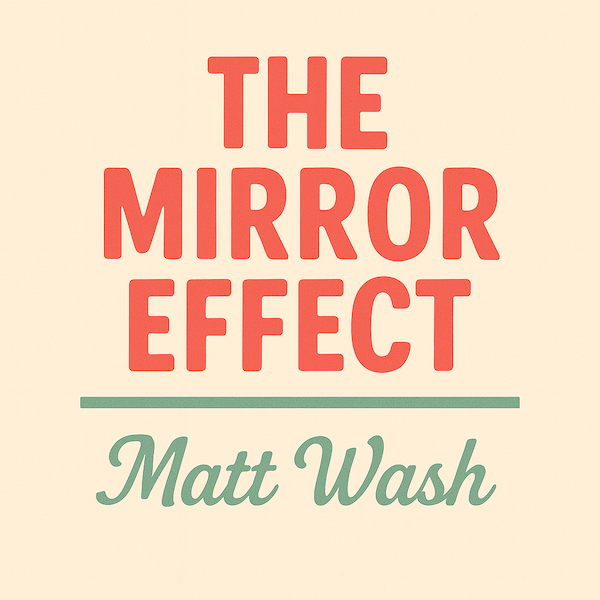I caught up with Matt Wash, CEO at Bimbeats, for this issue because I felt like our first chat left a lot to dive into. Right off the bat, he pointed out something interesting about how effort, value, and engagement don’t quite match up in today’s attention-driven world. We also talked about how this tension plays out in AEC organisations, where both strategic pros and product founders often feel like their work gets boiled down to simple labels. We really unpack why the industry tends to push back against fresh ideas, how complexity often gets lost in the shuffle, and what actually makes a difference when it comes to creating real value.
About Matt
With nearly 30 years of experience in the AEC industry, Matt has championed innovative tools and workflows to support lean processes, adding value and eliminating waste throughout the project lifecycle. Now translating technical opportunities into commercial reality, he believes successful businesses must embrace reverse mentoring, combining industry experience with innovative delivery methods through curiosity, continuous improvement, and a growth mindset.
Introduction
“There’s often a surprising disconnect between the effort you put into a LinkedIn post, the value of the content, and the engagement it receives. In today’s attention economy, where people are time-poor and constantly scrolling, striking the right balance between grabbing attention and delivering meaningful value is tougher than it looks.”
Matt Wash
Two conversations happen simultaneously across the AEC industry. Product founders spend hours crafting detailed analyses of genuine business problems, only to see their insights go ignored while surface-level posts rack up hundreds of likes. Meanwhile, professionals who bring strategic thinking into traditional firms find themselves constantly explaining their value to colleagues, who often default to reducing them into categories they already understand: ‘the BIM guy,’ ‘the Dynamo person,’ or simply ‘tech support.’ This reduction isn’t hostile; it’s how hierarchical organisations cope with uncertainty. When decision-makers lack a frame of reference for a new capability, they collapse it into something familiar.
This isn’t just about social media algorithms or workplace politics. Both scenarios reveal the same structural reality: whether you’re marketing products externally or establishing professional value internally, you stumble against entrenched patterns in how the industry interprets and values new ideas.
The translation challenge
The core issue is identical across both contexts: translating technical capability into business language within an industry culture that systematically resists that translation. This resistance stems less from aversion to change and more from structural misalignment. Decision-making power often concentrates in leaders who lack the technical context to evaluate strategic innovation, while the change management required spans multiple organisational levels.
Technical professionals frequently assume their expertise and capabilities will naturally lead to success, but superior products or technology rarely guarantee market acceptance. Companies like Bimbeats consistently demonstrate this with clear ROI, but decision-makers often categorise them as another “BIM tool” rather than evaluating their strategic value.
Professionals bringing strategic capabilities into traditional AEC environments face parallel resistance. Instead of recognition for bridging technical possibilities with business value, they get sorted into comfortable categories: “the tech person” who handles digital tools, “the process person” who optimises workflows. The actual contribution of strategic value creation gets lost in familiar organisational labels.
The solution lies in reframing technical capability as problem-solving narrative. Instead of presenting a ‘BIM optimisation tool,’ position it as ‘the system that eliminated three weeks of coordination delays on the project.’ Rather than describing yourself as ‘the strategic digital professional,’ become ‘the person who identified why our delivery timelines consistently exceeded estimates and developed the process changes that brought us back on schedule.

When substance meets the engagement economy
Both external product marketing and internal professional positioning operate within identical incentive structures: appearance consistently outperforms substance.
The disconnect between effort, value, and response spans all contexts. Analytical deep dives with a comprehensive human understanding of localised nuances and rationalisation receive minimal engagement while AI-generated productivity tips generate hundreds of interactions. Thoughtful strategic collaboration proposals go unanswered while surface-level technical discussions flourish.
This pattern reflects organisational gravitational pull toward safe, familiar territory over the vulnerable thinking required for genuine business value discussions. The current environment demands leadership insights be distilled into rapid-consumption formats that mirror social media patterns. This preference systematically excludes deeper analytical work; comprehensive strategic documents get dismissed as impractical within existing decision-making timeframes.
The compression problem: Complex strategic thinking is forced into inadequate formats, resulting in critical translation failures. Leaders struggle to effectively translate engineering problems into business opportunities, then into actionable digital strategies, and back into viable engineering criteria. Strategic decisions get made without a proper understanding of underlying technical realities, leading to innovations that solve non-existent problems.
Matt observes this pattern directly: “Most businesses want to skip the bit between CAD and AI, thinking AI will handle computational design and BIM for them. Without realising that you need structured data, reliable knowledge that has to be fed into the system.”
More concerning is the systematic exclusion of voices most qualified to identify genuine problems worth solving. Engineering perspectives get dismissed not because these professionals resist change, but because their insights challenge predetermined organisational narratives. Organisations prioritise narrative consistency over strategic accuracy, transforming planning from a discovery exercise into a confirmation process.
This creates what relationship-building approaches can address: the need for authentic dialogue that allows technical expertise to inform strategic direction while building the trust necessary for decision-makers to engage with unfamiliar value propositions.
What actually works: relationships overreach
Despite these structural obstacles, both external product marketing and internal professional development succeed through the same approach: authentic relationship-building over algorithmic engagement.
Matt’s experience validates this: “95% of our sales come from someone talking to someone else about what we do, saying it’s been really good for us.” This aligns with research showing word-of-mouth drives 20-50% of B2B purchasing decisions. Similarly, successful internal strategic collaborations emerge from one-on-one conversations where value gets demonstrated directly.
This approach builds on proven traditional construction practices. Traditional relationship development succeeded through direct, personal value creation; solving immediate needs while creating opportunities for larger strategic conversations. The fundamental principle remains consistent: provide genuine value that opens doors to authentic dialogue.
The proven approach integrates across all organisational levels:
- Prioritise relationships over reach – One meaningful conversation creates more value than hundreds of social media interactions.
- Show value through consistent actions – Demonstrate rather than explain, building trust over time
- Find appropriate venues – Seek environments where substantive discussion gets valued over surface-level engagement.
- Accept realistic timelines – Cultural change happens gradually, but authentic value compounds.
Addressing structural challenges: Organisations can establish structured mentorship programs pairing employees across generations, but equally important is implementing reverse mentorship that recognises younger professionals often possess strategic insights senior decision-makers need. However, such programs must encourage the vulnerable conversations necessary for genuine business value discussions rather than defaulting to surface-level exchanges.
The leadership development component proves crucial: organisations frequently promote technical performers without training in facilitating multidirectional knowledge sharing or creating environments where strategic innovation discussions can flourish.
The modern challenge involves scaling traditional relationship-building principles through digital channels while maintaining directness and practical value. Those who succeed translate face-to-face relationship building into scalable approaches while navigating organisational resistance and professional identity challenges simultaneously.
Conclusion
Success in AEC requires navigating organisational dynamics where traditional hierarchies concentrate decision-making authority with leaders who may lack the technical context to evaluate strategic innovation. The industry’s tendency toward familiar categorisation, cost-first decision-making, and hierarchical knowledge-sharing creates parallel obstacles for product founders and strategic professionals.
The solution isn’t better marketing tactics or clearer value propositions; it’s building authentic relationships while consistently demonstrating value over time. In Millar’s framework, this means helping organisations become simultaneously “smart” (strategic vision), “fit” (operational capabilities), and “healthy” (cultural foundations) through patient, relationship-driven approaches that gradually expand both technical literacy and strategic authority.
In an industry where organisational change occurs slowly, this approach becomes both the most demanding and most sustainable path to success, as it builds organisational resilience and adaptability. Those who master relationship-driven value demonstration don’t just overcome barriers; they transform them into competitive advantages, creating organisations better positioned to navigate industry evolution and capitalise on emerging opportunities.
